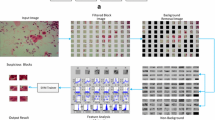Abstract
The second most common and preventable form of cancer among women worldwide is cervical cancer in which the signs for this disease can be detected in the early Pap smear screening of cervical cells. To improve the efficiency of expert diagnosis, we will need to automate the feature extraction of cervical cancer cells by the means of image processing techniques. This article employs image processing techniques to get the special features of normal, precancerous and cancerous cell images. We extract spectral features for cervical cancer cell detection. This article uses the noise decrease filters, OTSU threshold to make it ready for processing through 2-D Fourier and logarithmic transforms. By drawing the linear plot, we will be able to extract the feature of normal, precancerous and cancerous cells according to the texture and morphology automatically. These linear plots will be unique which can separate the cells in three groups of normal, precancerous and cancerous cells. This separation is done with 100% accuracy due to the unique linear plots. The experiment shows that extracted unique features for each cell will provide evidences for diagnoses even in cytopathology images in which the nucleus and cytoplasm segmentation algorithms suffer from complex overlaying cells.






Similar content being viewed by others
References
Othman, N. H., Cancer of the cervix—from bleak past to bright future. Pustaka Reka Publishing Company, Kelantan, Malaysia, 2003.
V. Linasmita, Cervical cancer screening in Thailand –FHI-satellite meeting on the prevention and early detection of cervical cancer in the Asia and the Pacific region, 2006.
Bazoon, M., Stacey, D. A., Chen, C., et al., A hierarchical artificial neural network system for the classification of cervical cells. IEEE World Congress on Computational Intelligence. IEEE International Conference on Neural Networks 3526:3525–3529, 1994.
Kemp, R. A., MacAulay, C., Garner, D., et al., Detection of malignancy associated changes in cervical cell nuclei using feed-forward neural networks. Analytical Cellular Pathology 14:31–40, 1997.
Pernick, B. J., Kopp, R. E., Lisa, J., et al., Screening of cervical cytological samples using coherent optical processing. Part 1 (ET). Appl. Opt 17:21, 1978.
Ricketts, I. W., Cervical cell image inspection—a task for artificial neural networks. Network: Computation in Neural Systems 3:15–18, 1992.
Ricketts, I.W., Banda-Gamboa, H., Cairns A.Y., et al. Towards the automated prescreening of cervical smears.Applications of Image Processing in Mass Health Screening, IEE Colloquium on, 1992; 7/1–7/4
McKenna, S. J., Ricketts, I. W., Cairns, A. Y., et al. A comparison of neural network architectures for cervical cell classification. Third International Conference on Artificial Neural Networks. 105–109:1993.
Walker, R. F., Jackway, P., Lovell, B., et al. Classification of Cervical Cell Nuclei using Morphological Segmentation and Textural Feature Extraction.Second Australian and New Zealand Conference on Intelligent Information Systems. 297–301:1994.
Harandi, N. M., Sadri, S., Moghaddam, N. A., and Amirfattahi, R., An Automated Method for Segmentation of Epithelial Cervical Cells in Images of ThinPrep. Journal of Medical Systems. 34(6):1043–1058, 2010.
Mat-Isa, N. A., Automated edge detection technique for pap smear images using moving K-means clustering and modified seed based region growing algorithm. Int J Comput Internet Manage 13(3):45–59, 2005.
Mat-Isa, N. A., Mashor, M. Y., and Othman, N. H., An automated cervical pre-cancerous diagnostic system. Artificial Intelligence in Medicine 42:1–11, 2008.
Mashor, M. Y., Hybrid training algorithm for RBF network. Int J Comput Internet Manage 8(2):50–65, 2000.
McKenna, S. J., Ricketts, I. W., Cairns, A. Y., et al. Cascadecorrelation neural networks for the classification of cervical cells. Neural Networks for Image Processing Applications, IEE Colloquium on. 5/1–5/4:1992.
Ricketts, I.W., Banda-Gamboa, H., Cairns, A.Y., et al. Automatic classification of cervical cells-using the frequency domain. Applications of Image Processing in Mass Health Screening, IEE Colloquium on. 9/1–9/4:1992.
Russ. J. C. The Image Processing Handbook Fifth Edition. 2009.
Gonzales, R.C., Woods E. R. Digital Image Processing. 2007.
Conflicts of interests
The authors had no competing interests to declare in relation to this article.
Author information
Authors and Affiliations
Corresponding author
Rights and permissions
About this article
Cite this article
Sokouti, B., Haghipour, S. & Tabrizi, A.D. A Pilot Study on Image Analysis Techniques for Extracting Early Uterine Cervix Cancer Cell Features. J Med Syst 36, 1901–1907 (2012). https://doi.org/10.1007/s10916-010-9649-y
Received:
Accepted:
Published:
Issue Date:
DOI: https://doi.org/10.1007/s10916-010-9649-y




